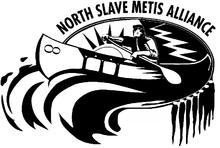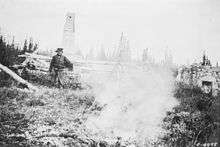North Slave Métis Alliance
 | |
| Founded | 1996 |
|---|---|
| Type | Non-profit |
| Location | |
Area served | Northwest Territories |
Key people | William (Bill) A. Enge (current president) |
| Mission | Unite the membership of the community of Indigenous Métis of the North Slave Region area of the Northwest Territories |
| Website | http://www.nsma.net/ |
| Aboriginal peoples in Canada |
|---|
|
History
|
|
Politics
|
|
Culture
|
|
Demographics
|
|
Religions |
|
Index
|
|
Wikiprojects Portal
WikiProject
First Nations Inuit Métis |
The North Slave Métis Alliance is a non-profit society that represents the Aboriginal rights-bearing Métis people of the Northwest Territories, who primarily exercise their Aboriginal rights north and east of Great Slave Lake.[1] The NSMA’s mandate includes: The assertion, protection, and implementation of the Aboriginal rights of the North Slave Métis People; and the exercise of Métis responsibility to protect the environment and to promote and enhance Métis education, economic, social, and cultural development.[2] The NSMA is vitally concerned with the protection, preservation, and sustainable use of its traditional lands and resources. With that in mind, the NSMA is committed to principles of economic sustainability, environmental stewardship, and self-determination in respect to its traditional lands and resources.[3]
The North Slave Métis Alliance (NSMA) has been registered as a non-profit society in the Northwest Territories since 1996. The organization exists for the stated purpose of negotiating a regionally based comprehensive claim centered in the North Slave Region of the Northwest Territories. Prior to 1996, their members were represented in the 1975-1990 Dene-Métis Comprehensive Claim negotiation process by the Métis Nation of the Northwest Territories (MNNWT), which was formed in 1972 to represent all indigenous Métis in the Northwest Territories. This organisation was disbanded after the Final Agreement was rejected, and the pan-territorial process was abandoned in favor of the pursuit of regional claims. The North Slave Métis Alliance was endorsed by the MNNWT as the North Slave Métis regional land claim organisation before the MNNWT was disbanded.[4][5] The alliance represents Metis in Yellowknife, Rae-Edzo, Wha Ti, Gameti (Rae Lakes), Wekweti (Snare Lake), Dettah and Ndilo. The NSMA sponsors a number of local events, such as the annual Aboriginal Day celebration in downtown Yellowknife, which includes a parade, fish fry, and musical performances near city hall.[6]
In 2013, the NSMA won its caribou harvest lawsuit against the government of the Northwest Territories in the Supreme Court of the Northwest Territories. The court found that the government of the Northwest Territories had an obligation to consult and accommodate the NSMA and failed in its obligation as a Crown actor. The court recognized that the members of the NSMA hold Aboriginal rights over their traditional lands.[7]
Leadership
NSMA presidents serve a four-year term.[8] The successive presidents of the NSMA have been:[9]
| President | From | To |
|---|---|---|
| William (Bill) A. Enge | November 2004 | Present |
| Robert "Sholto" Douglas | April 2003 | November 2003 |
| Bob Turner | December 2002 | 2003 |
| Clem Paul | 1996 | 2002 |
History of the North Slave Métis People

The North Slave Métis have continuously used and occupied the territory north and east of Great Slave Lake since the mid-18th century.[10][11][12] By the early-19th century, the North Slave Métis community in the Great Slave Lake area was distinct from other indigenous groups.[13] Outsiders easily identified them, largely because of their occupation and employment patterns.[14] They were "prized as fur-trade employees for their language ability, skills in living on the land, and influence in the Indian populations".[15] North Slave Métis people tended to be highly mobile and have a regional consciousness.[16][17] Communities were characterized by a regional network within which there would be certain fixed settlements, connected by transportation systems of river routes, cart trails, and portages along which people settled. Their traditional territory followed hunting, trapping, and trading trails north to the Great Bear Lake and east into what is now Nunavut.[18] Historic North Slave Métis settlements, such as Old Fort Rae, Lac La Martre, Yellowknife River, Old Fort Providence, Fort Resolution, Beaulieu Fort (now known as Lutselk'e), and Fort Reliance, existed before European powers established effective political and legal control over the geographic area.[19][20][21]
Notable North Slave Métis
- François Beaulieu II (1771 - † Nov 1872)- Beaulieu II was one of the "founding fathers" of the Great Slave Lake area Métis. The Beaulieu family was already established in the region when the European fur trade first arrived and took up residency in the area.[22] Beaulieu and his family inhabited many regions of the north, demonstrating the regional nature of the Métis.[23][24][25][26][27][28]
References
- ↑ The Standing Senate Committee On Aboriginal Peoples Evidence, Parliament of Canada (Ottawa, Wednesday, October 17, 2012)
- ↑ The Standing Senate Committee On Aboriginal Peoples Evidence, Parliament of Canada (Ottawa, Wednesday, October 17, 2012)
- ↑ Public Hearing Transcript February 19, 2013 - Yellowknife, NECHALACHO RARE EARTH ELEMENT PROJECT - EA1011-001 [2010]
- ↑ Metis Nation (July 1996). "Metis Nation – Northwest Territories 24th Annual General Assembly Resolution #4".
- ↑ North Slave Metis Alliance (2001). Can't Live Without Work: Environmental, Social, Economic and Cultural Concerns. Yellowknife.
- ↑ "Aboriginal Day celebrated in N.W.T.". CBC News North. 21 June 2010. Retrieved 10 December 2012.
- ↑ Enge v. Mandeville et al, 2013 NWTSC 33 < http://devlingailus.com/pdfs/Enge_v_Mandeville_Case_Brief.pdf >
- ↑ Robinson, April (15 April 2009). "New 4-year term for Metis alliance". Northern News Services. Retrieved 10 December 2012.
- ↑ Alliance in turmoil (Northern News Services, 2003)
- ↑ Petitot, E (1891). Autours du grand lace des Esclaves. Paris: Nouvelle Librairie Parisienne.
- ↑ Petitot, E (1887). En route pour la mer galciale. Paris: Letouszey et ane.
- ↑ Mackenzie, Alexander. Voyages from Montreal Through the Continent of North America to the Frozen and Pacific Oceans in 1789 and 1793 Vol. I (1902 ed.)
- ↑ Jones, G. 2005. Historical Profile of the Great Slave Lake Area’s Mixed European-Indian Ancestry Community. Unpublished manuscript, Department of Justice Canada and Office of the Federal Interlocutor for Métis and Non- Status Indians.
- ↑ Jones, G. 2005. Historical Profile of the Great Slave Lake Area’s Mixed European-Indian Ancestry Community. Unpublished manuscript, Department of Justice Canada and Office of the Federal Interlocutor for Métis and Non- Status Indians.
- ↑ Jones, G (2005). "Historical Profile of the Great Slave Lake Area's Mixed European-Indian Ancestry Community". Department of Justice Canada and Office of the Federal Interlocutor for Métis and Non- Status Indians.
- ↑ Jones, G. 2005. Historical Profile of the Great Slave Lake Area’s Mixed European-Indian Ancestry Community. Unpublished manuscript, Department of Justice Canada and Office of the Federal Interlocutor for Métis and Non- Status Indians.
- ↑ Slobodin, Richard. Metis of the MacKenzie District. Canadian Research centre for Anthropology 1966.
- ↑ Jones, G. 2005. Historical Profile of the Great Slave Lake Area’s Mixed European-Indian Ancestry Community. Unpublished manuscript, Department of Justice Canada and Office of the Federal Interlocutor for Métis and Non- Status Indians.
- ↑ Bellman, J. Picking up the Threads: Métis History in the Mackenzie Basin. Métis Heritage Association of the Northwest Territories and Parks Canada-Canadian Heritrage. pp. 5–29.
- ↑ Lawrence, A (2008). "A program of research related to historical Métis communities". JustResearch. Research and Statistics Division, Department of Justice Canada (15): 12–19.
- ↑ Jones, G (2005). "Historical Profile of the Great Slave Lake Area's Mixed European-Indian Ancestry Community". Department of Justice Canada and Office of the Federal Interlocutor for Métis and Non- Status Indians.
- ↑ Hanks, C (24 May 2000). "François Beaulieu II: The origins of the Métis in the Far Northwest". Selected Papers of Rupert's Land Colloquium 2000.
- ↑ HBC Archives. (B.239/k/2&3)
- ↑ HBC Archives. (D.38/6b)
- ↑ Pike, Warburton (1892). The barren ground of northern Canada. [Cover title: Journeys to the barren ground of northern Canada, 1889-1891; in search of musk-ox]
- ↑ Jones, Charles Jesse & Inman, Henry. (1899). Buffalo Jones’ forty years of adventure; a volume of facts gathered from experience. Topeka, Kans., Crane & co
- ↑ Guy Blanchet, “Exploring with Sousi [Beaulieu] and Black Basile,”Beaver, Autumn 1964, Vol. 44, No.2, Out. 295,
- ↑ Seton, E. T. (1911). The Arctic prairies: a canoe-journey of 2,000 miles in search of the caribou; being the account of a voyage to the region north of Aylmer Lake. C. Scribner's sons.
North Slave Métis Alliance Research
- Can't Live Without Work (NSMA, 2001)
- Traditional Land Use, Occupancy and Knowledge Report (2013) - De Beers Gahcho Kue Project (NSMA, 2013)
Further reading with reference to North Slave Métis
- Abel, Kerry (1993). Drum Songs: Glimpses of Dene History. Montreal: McGill-Queen's University Press.
- Jones, Charles Jesse & Inman, Henry. (1899). Buffalo Jones’ forty years of adventure; a volume of facts gathered from experience. Topeka, Kans., Crane & co
- Mackenzie, Alexander. Voyages from Montreal Through the Continent of North America to the Frozen and Pacific Oceans in 1789 and 1793 Vol. I (1902 ed.)
- Pike, Warburton (1892). The barren ground of northern Canada. [Cover title: Journeys to the barren ground of northern Canada, 1889-1891; in search of musk-ox]
- Seton, E. T. (1911). The Arctic prairies: a canoe-journey of 2,000 miles in search of the caribou; being the account of a voyage to the region north of Aylmer Lake. C. Scribner's sons
- Slobodin, Richard (1966). Metis of the Mackenzie District. Ottawa: Saint-Paul University.
- Whitney, C. (1896). On snow-shoes to the barren grounds: twenty-eight hundred miles after musk-oxen and wood-bison. Harper.
Archived News
- North Slave Métis denied land claim (Northern Journal, 2013)
- North Slave Métis fight feds over devolution (CBC, 2013)
- Metis Alliance suing federal government (Northern News Services, 2013)
- Caribou hunting ban won't be tested in court: N.W.T. (CBC, 2010)
- Aboriginal Day celebrated in N.W.T. (CBC News North, 2010)
- Inspection gaps at Diavik mine: Metis alliance(CBC, 2009)
- New 4-year term for Metis alliance (Northern News Services, 2009)
- De Beers, Metis sign deal on Snap Lake mine (CBC, 2006)
